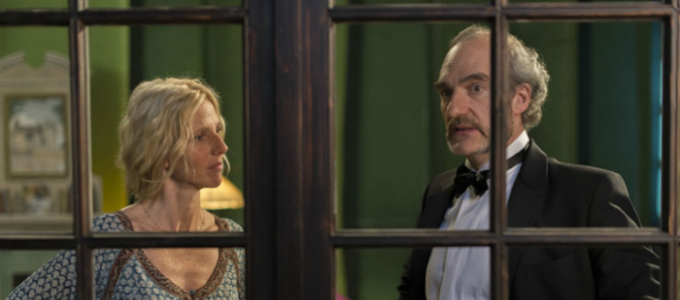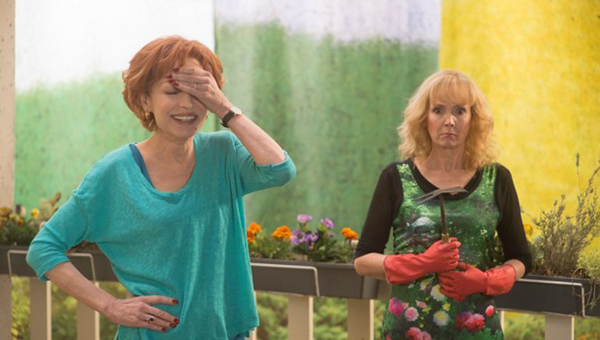
Alain Resnais’ final film isn’t going to surprise anyone who has seen his last few features. If you’re looking for a return to meditations on time and memory in the Resnais of HIROSHIMA MON AMOUR, LAST YEAR AT MARIENBAD or even MURIEL, you won’t find it here. Released in France only weeks after the death of Resnais on 1st March 2014, LIFE OF RILEY is by contrast a warm and memorable film that in many ways is more authentically characteristic of the director, the man, his nature and his obsessions. As such it proves to be a fitting testament to one of the most important filmmakers of the last 60 years.
You need only refer to the source of the script to see where LIFE OF RILEY fits into Resnais’ oeuvre. Written by Alan Ayckbourn, whose plays formed the basis for SMOKING/NO SMOKING and PRIVATE FEARS IN PUBLIC PLACES, LIFE OF RILEY sees Resnais operating in light comic theatre mode. The treatment here is similar to those earlier Ayckbourns, with little concession to naturalism in either the sets or the dramatic situations. It rather reflects the director’s latter-day interests in blockbuster US TV serials, popular music theatre, bandes dessinées comics (BD) and graphic novels. It’s hard to imagine how those influences can be brought to bear on Ayckbourn’s domestic drama about a group of couples whose lives and loves become intertwined, but using those techniques Resnais manages nonetheless to draw out undercurrents and insinuations in a style that if can’t exactly be called realism, achieves a kind of hyper-realism.
It is in fact BD author Blutch, having previously contributed the poster design and provided some of the influence on the style of WILD GRASS, who is the main inspiration for the approach taken in LIFE OF RILEY. Unable to rely on nuance in voice, sound or acting, comics are forced to rely on other methods of expression, and Resnais appropriates this language for his film, using colourfully painted flat backdrops and sets, and inserting cutaway frames for certain monologues with heads superimposed over cross-hatched backgrounds. For a film which has recourse to those more traditional methods of expression, this does seem counterintuitive (and whether it works or not is of course debatable), but it’s a bold gesture from a director who has remained idiosyncratic and experimental right to the end. One need only think of the combination of music, lip-syncing and jellyfish in ON CONNAIT LA CHANSON to see how Resnais constantly strived to expand the traditional language of cinematic and dramatic expression in a popular medium.
Just because Resnais avoids naturalism and realism doesn’t mean that he neglects to treat the drama seriously…
Abstract and experimental are, however, not words one would use to describe Alan Ayckbourn’s source play. Questions are likely to be raised over whether this is really the right kind of material for an avant-garde filmmaker. Nevertheless, Resnais finds the little human dramas of these drawing room plays touching, unsentimental and reflective of the experience of life for many. LIFE OF RILEY takes place almost entirely outdoors in English country gardens, in a little corner of the Yorkshire Dales (where everyone nonetheless speaks French). We only ever see three couples – Kathryn and Colin (Sabine Azéma and Hippolyte Girardot), Tamara and Jack (Caroline Sihol and Michel Vuillermoz) and Monica and Simeon (Sandrine Kiberlain and André Dussollier). While rehearsing and preparing for an amateur play, their relatively secure and comfortable existence is challenged by the news that their friend George Riley is dying.
George is never seen in the film, yet his presence is there throughout, and you might even consider – given the title of the film (in English anyway) – that he’s actually the most important figure in the whole film. It’s hard not to see the invisible manipulator of the drama, George, as a substitute for the reclusive filmmaker himself. George’s off-screen behaviour affects everyone, not just coming between his ex-wife Monica and her new love Simeon, but also flirting with and manipulating the other women by offering them a final fling with him in Tenerife, even as he has only months to live. It all becomes a bit farcical. Just because Resnais avoids naturalism and realism in the drama and the mise en scène however doesn’t mean that he neglects to treat the drama seriously, and this is reflected in his careful direction of the cast. The members of the director’s regular toupe are completely on the note here, as always (Dussolier, Azéma and latterly Vuillermoz), but all the actors are clearly alert to the underlying tensions and quirks of personality in the characters. Azéma in particular is, as ever, an acquired taste, but she has exactly the right kind of twinkle of mischievousness and comic exaggeration that perfectly meets Resnais’ intentions.
The English title for the film might be inherited from Alan Ayckbourn’s original drama, but Resnais’ choice for the French version is significant. AIMER, BOIRE ET CHANTER literally translates as ‘Love, Drink and Sing’ or colloquially as ‘Eat, Drink and Be Merry’. That is a rough equivalent of what we mean by LIFE OF RILEY in English, but it clearly means more than that to Resnais, who similarly introduced a very specific slant on PRIVATE FEARS IN PUBLIC PLACES when he renamed it as COEURS (‘Hearts’) for his film version. For all the twists here, the drama hardly amounts to anything more than a domestic storm in a tea-cup that reaches a resolution without any real damage being caused. What’s significant, however, is that it’s resolved with a death. Death resolves everything, so why not have fun before you die?.
That might seem a little trite from a director of the stature of Resnais, who has examined this question with considerably greater philosophical gravitas and formal experimentation in L’AMOUR À MORT, but it’s probably the single most important message that he has to impart through his cinematic output. Ending as it does with the funeral of George Riley (with a neat little twist involved) and with the death of Resnais himself – a coup that could well have been imagined by the 91 year-old director – it makes for a particularly poignant closing scene in his final, beautiful film.
httpvh://youtu.be/Irrf7HhSHTw

